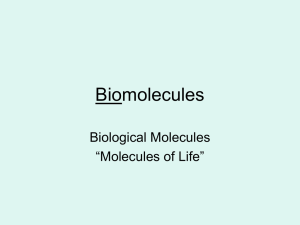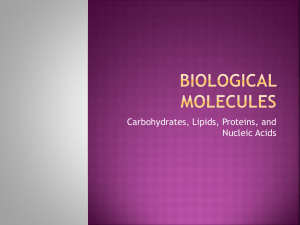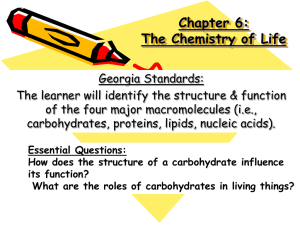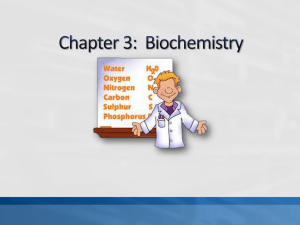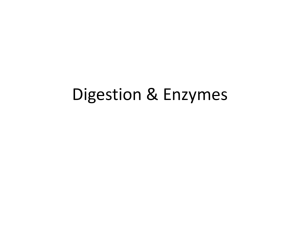Carbon-Based Molecules: Biology Presentation
advertisement
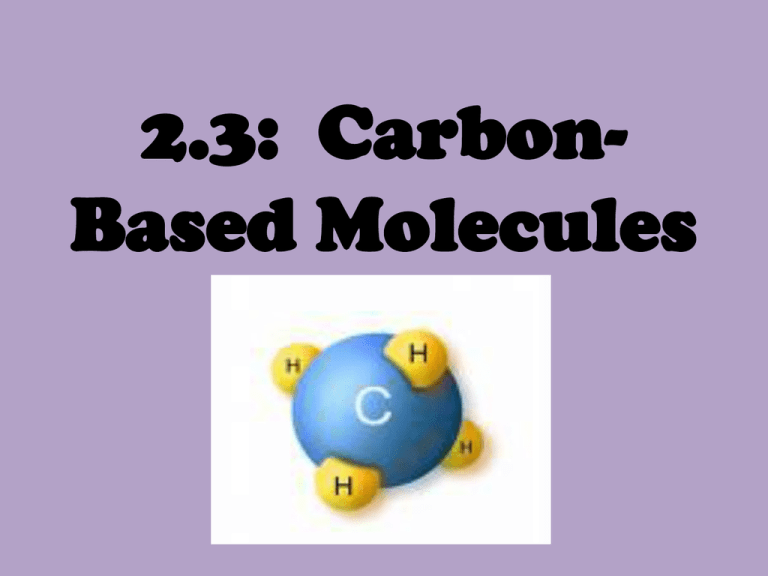
2.3: CarbonBased Molecules Carbon-based molecules are the foundation of life. Bonding Properties of Carbon • Carbon forms covalent bonds with up to four other atoms, including other carbon atoms. 1 3, 4 2 Structure of carbon-based molecules… • Three general types: 1. straight chain H H Cl H H | | | | | H - C- C - C - C - C - H | | | | | H H H H H 3-chloropentane Structure of carbon-based molecules… • Three general types: 2. Branched chain Structure of carbon-based molecules… • Three general types: 3. Ring • Many carbon-based molecules are made of many small subunits bonded together. – Monomers are the individual subunits. – Polymers are made of many monomers. Four Types of CarbonBased Molecules Carbohydrates Lipids Proteins Nucleic Acids ALL four are found in LIVING things. Carbohydrates • Organic molecules made of the elements carbon, hydrogen, and oxygen (CHO) • Includes sugars and starches • Pasta, bread, and fruit are high in carbohydrates Structure of Carbohydrates • Monomer • Monosaccharides – “saccharide” means sugar – simple sugars – Glucose, galactose, fructose Structure of Carbohydrates • Disaccharide • Two monosaccharide molecules bonded together • Sucrose, or table sugar, made of one glucose and one fructose molecule Structure of Carbohydrates • Polymer • Polysaccharides – Chains of monosaccharides – starches, cellulose, and glycogen Function of Carbohydrates • Can be broken down to provide energy for cells. – Glucose-main source of energy for cells, product of photosynthesis • Provide us with energy – Sugar rush then crash • Some carbohydrates are part of cell structure. – Cellulose-makes up the cell wall of plant cells LIPIDS • Organic molecules made of the elements carbon, hydrogen, and oxygen (CHO) • Nonpolar molecules –Do not dissolve in water • Include fats, oils, cholesterol, and wax Structure of Lipids • Fatty acids bonded to glycerol. – Glycerol-3 hydroxyl groups – Fatty acids-long carbon chains Two different types of fatty acids found in fats and oils: oSaturated fatty acids oUnsaturated fatty acids Two Types of Fatty Acids Functions of Lipids • Used for long term energy storage • Make up cell membranes – Phospholipid bilayer • Used to make hormones – Testosterone (males) & estrogen (females) • Insulate and waterproof organisms – Cutin-waxy substance that coats leaves of plants to help prevent water loss Lipid Polymer-Phospholipid • Consists of glycerol, two fatty acids (nonpolar tails) and a phosphate group (polar head of molecule) • Makes up ALL cell membranes Lipid Polymer-Triglycerides • Consists of glycerol and three fatty acids • Type of fat found in your blood. – Your body uses them for energy. • You need some triglycerides for good health. – But high triglycerides can raise your risk of heart disease and may be a sign of metabolic syndrome Nucleic Acids • EXTREMELY long carbon-based molecules made of carbon, hydrogen, oxygen, nitrogen, and phosphorus (CHONP) Structure of Nucleic Acids • Monomer A phosphate group – Nucleotide • made of a five-carbon sugar, phosphate group, and a nitrogen base. • 5 kinds: Adenine, Thymine, Cytosine, Guanine, & Uracil • Polymers – DNA-Deoxyribonuleic Acid – RNA-Ribonucleic Acid deoxyribose (sugar) nitrogen-containing molecule, called a base Function of Nucleic Acids • DNA stores genetic information • RNA builds proteins using information from DNA DNA RNA Proteins • Large organic molecules made of carbon, hydrogen, oxygen, and nitrogen (CHON) • Essential to all life • Foods high in proteins: – Poultry, fish, eggs, beans, nuts, peanut butter, milk Structure of Proteins • Monomer – Amino acid • Contain an amino group and a carboxyl group • Interact to give a protein its shape and function • Peptide bonds form between amino acids to form chains • Organisms use 20 different amino acids to build proteins – Your body makes 12, others come from food you eat Structure of Proteins • Polymer – Protein – Also called polypeptide • Each protein has a different arrangement of amino acids • Incorrect amino acid sequence and/or arrangement changes the protein’s structure and function Function of Proteins • Building and connecting materials of living things – Collagen-forms bones, tendons, ligaments, and cartilage • Take part in chemical reactions and transport materials – Hormones, antibodies, and enzymes Function of Proteins • Longer-lasting energy source than carbohydrates because broken down more slowly • Involved in eyesight, digestion, etc. as well 2.5: Enzymes Enzymes are catalysts for chemical reactions in living things. Chemical Reactions • Substances are changed into different substances by breaking and forming chemical bonds – Reactants are changed to form products • Cell growth, reproduction, interaction with the environment, and response to stimuli are the result of a chemical reaction Reactants Products Catalysts • Lowers activation energy • Speed up chemical reactions Activation Energy • Energy that needs to be absorbed for a chemical reaction to start –Energy reactants need in order to react • Break bonds and form new ones Rate of Chemical Reactions • Biochemical reactions must occur at certain speeds, or rates, in order to be useful. • Rate of a reaction depends on: – Temperature – Concentration of the chemicals – Surface area Enzymes as Catalysts • Enzymes are proteins • Makes reactions that happen in cells possible – Lower activation energy and speed up reaction rate • Without enzymes, many reactions would not happen – Others would occur too slowly for the organism to survive • Enzyme will not be used up or changed during the reaction Structure of Enzymes • Gives reactants a site where they can come together to react substrates (reactants) – Substrates-reactants affected by enzyme • Substrates bind to the active site • Shape of substrate and active site are complimentary, or opposite – Fit together like a lock and key enzyme Substrates bind to an enzyme at certain places called active sites. Lock and Key Model Illustrates how enzymes function Substrates bind to an enzyme at certain places called active sites. The enzyme brings substrates together and weakens their bonds. The catalyzed reaction forms a product that is released from the enzyme. Structure of Enzymes • Allows only certain reactants to bind to the enzyme – An organism may have thousands of different enzymes – Each is specific to one chemical reaction • An enzyme’s function depends on its structure. Functions of Enzymes • Energy-releasing enzymes power cell functions • Enzymes in nerve cells produce neurotransmitters to carry impulses from nerves to muscles • Muscle cells have enzymes that are triggered in response to the neurotransmitters Functions of Enzymes • Blood contains enzyme carbonic anhydrase – Catalyzes reaction in your blood where carbon dioxide combines with water to form carbonic acid – Makes reaction one million times faster so that carbon dioxide does not build up in your blood, which could be fatal • Enzyme lipase in the pancrease – Speeds up digestion of lipids Functions of Enzymes • Disruptions in homeostasis can prevent enzymes from functioning. – Enzymes function best in a small range of conditions. – Changes in temperature and pH can break hydrogen bonds. – Destroyed at temperatures above 50˚C – Work best at pH of 7
